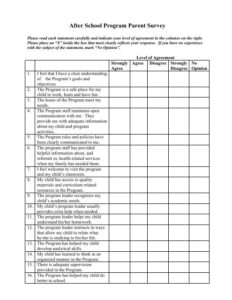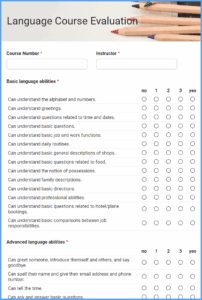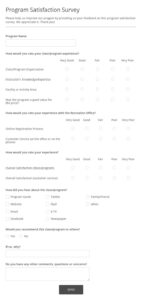Embarking on any project, whether it is a community development initiative, a new business strategy, or an educational program, often comes with a desire to understand its true impact. How do you know if your efforts are truly making a difference, or if adjustments are needed along the way? This is where monitoring and evaluation, commonly known as M&E, steps in as your essential compass. It is not just about ticking boxes; it is about gathering real insights that inform decisions, celebrate successes, and pinpoint areas for growth. A well-designed monitoring and evaluation survey template becomes an invaluable tool in this journey, streamlining data collection and ensuring you capture what truly matters.
Think of M&E as the backbone of accountability and learning. Without a structured approach, you risk collecting inconsistent data, missing crucial feedback, or simply being overwhelmed by unstructured information. That is precisely why having a robust survey template can transform your M&E efforts from a daunting task into a manageable and incredibly insightful process. It provides a standardized framework, ensuring that every piece of feedback and every data point contributes to a clearer picture of your project’s performance and impact. It helps you ask the right questions at the right time, ensuring your efforts lead to meaningful improvements and sustainable results.
Why a Solid M&E Survey Template Is Your Best Friend
Imagine trying to bake a cake without a recipe; you might end up with something edible, but consistency would be a challenge, and recreating it perfectly would be even harder. The same goes for M&E. A well-crafted template acts as your recipe, providing a clear, structured guide for collecting data. It ensures that regardless of who is conducting the survey or when it is administered, the core questions remain consistent, allowing for accurate comparison over time and across different groups. This consistency is vital for spotting trends, identifying correlations, and making data-driven decisions.
Beyond consistency, a template significantly boosts efficiency. Instead of drafting new questions from scratch for every data collection point, you have a pre-existing framework to build upon. This saves immense amounts of time and effort, freeing up your team to focus on analyzing the data rather than endlessly designing surveys. It also helps in standardizing data entry and analysis, making the entire process smoother from start to finish. This leads to more reliable data, which is the cornerstone of effective evaluation.
Furthermore, a comprehensive template ensures that all critical aspects of your project are covered. It acts as a reminder of the key indicators you should be tracking, preventing oversights that could lead to incomplete or skewed evaluations. From project inputs and activities to outputs, outcomes, and ultimately, impact, a good template will prompt you to gather information across the entire results chain. This holistic view is crucial for understanding the full story of your project’s journey and its contribution.
Ultimately, the power of a solid M&E survey template lies in its ability to empower you with actionable insights. When data is collected systematically and consistently, it becomes much easier to identify what is working well, what needs improvement, and why. This informed understanding allows for timely adjustments, resource reallocation, and strategic planning, ensuring your project remains on track to achieve its goals and maximize its positive influence.
Key Elements to Consider in Your Template
- Project Background and Objectives: Briefly describe the project and its specific goals.
- Target Audience Demographics: Collect relevant information about respondents (e.g., age, gender, role) to segment and understand responses better.
- Key Performance Indicators (KPIs): Questions directly related to your project’s specific indicators of success.
- Activity and Output Tracking: Questions on what activities were conducted and what direct results were produced.
- Outcome Assessment: Questions designed to measure the changes or benefits experienced by participants or beneficiaries.
- Impact Evaluation: Questions aimed at understanding the broader, long-term effects of the project.
- Challenges and Lessons Learned: Open-ended questions to gather qualitative feedback on obstacles encountered and insights gained.
- Recommendations for Improvement: Space for suggestions on how the project can be enhanced.
Crafting Your Own Effective Monitoring and Evaluation Survey Template
Building an effective monitoring and evaluation survey template isn’t just about copying and pasting; it is about tailoring it to the unique needs of your project. Start by clearly defining what you want to achieve with your M&E efforts. Are you looking to track progress, assess immediate outcomes, or understand long-term impact? Your objectives will dictate the types of questions you need to ask and the indicators you need to measure. Involve key stakeholders in this initial brainstorming phase to ensure all perspectives are considered and the template will be useful to everyone involved.
Once your objectives are clear, begin populating your template with questions that directly align with your project’s indicators. Use a mix of question types: multiple-choice for quantitative data, Likert scales for capturing perceptions and attitudes, and open-ended questions for rich, qualitative insights. Ensure that your questions are clear, unbiased, and easy for respondents to understand. Pilot test your survey with a small group before wider distribution to catch any ambiguities or issues that might affect data quality. This iterative process of drafting, testing, and refining is crucial for an optimal template.
Consider the various phases of your project. A baseline survey, conducted at the very beginning, will help establish a starting point against which all future progress can be measured. Mid-term surveys can track immediate progress and allow for course correction, while end-line surveys are essential for assessing final outcomes and overall impact. You might even need follow-up surveys to gauge sustainability. Each phase might require specific adaptations to your core monitoring and evaluation survey template, focusing on different aspects of the project’s lifecycle.
Finally, remember that your template is a living document. As your project evolves, so too should your M&E approach. Regularly review your template to ensure it remains relevant and effective. Are you still gathering the most important information? Are there new aspects of the project that need to be monitored? Is the language still appropriate for your audience? Being flexible and open to continuous improvement will ensure your template remains a powerful asset in your project management toolkit, helping you to tell a compelling story about your impact.
Having a robust framework for understanding your project’s journey is not just good practice; it is essential for achieving true success. By systematically gathering insights and learning from every step, you transform raw data into a powerful narrative of change and growth.
Embracing this methodical approach allows you to continuously refine your strategies, demonstrate accountability to your stakeholders, and ultimately maximize the positive difference you strive to make in the world.



